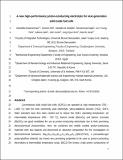Files in this item
A new high-performance proton-conducting electrolyte for next-generation solid oxide fuel cells
Item metadata
| dc.contributor.author | Radenahmad, Nikdalila | |
| dc.contributor.author | Afif, Ahmed | |
| dc.contributor.author | Abdalla, Abdalla M. | |
| dc.contributor.author | Saqib, Muhammad | |
| dc.contributor.author | Park, Jun-Young | |
| dc.contributor.author | Zaini, Juliana | |
| dc.contributor.author | Irvine, John | |
| dc.contributor.author | Hyun Kim, Jung | |
| dc.contributor.author | Azad, Abul K. | |
| dc.date.accessioned | 2021-07-23T23:36:08Z | |
| dc.date.available | 2021-07-23T23:36:08Z | |
| dc.date.issued | 2020-07-24 | |
| dc.identifier | 269174148 | |
| dc.identifier | a40818a3-0e2c-48af-b9cf-a50287aa5a11 | |
| dc.identifier | 000551479800001 | |
| dc.identifier | 85088377706 | |
| dc.identifier.citation | Radenahmad , N , Afif , A , Abdalla , A M , Saqib , M , Park , J-Y , Zaini , J , Irvine , J , Hyun Kim , J & Azad , A K 2020 , ' A new high-performance proton-conducting electrolyte for next-generation solid oxide fuel cells ' , Energy Technology , vol. Early View , 2000486 . https://doi.org/10.1002/ente.202000486 | en |
| dc.identifier.issn | 2194-4288 | |
| dc.identifier.other | RIS: urn:9DF10E99BA3FCDAB46A6B201C97C0416 | |
| dc.identifier.other | ORCID: /0000-0002-8394-3359/work/78204832 | |
| dc.identifier.uri | https://hdl.handle.net/10023/23619 | |
| dc.description | N. Radenahmad and A. Afif are thankful to Universiti Brunei Darussalam for sponsoring the UBD graduate scholarship to perform Ph.D. work at Brunei Darussalam. The authors are also grateful to the late Professor Sten Eriksson for supporting a summer scholarship for NR to accomplish a part of this work at Chalmers University of Technology, Sweden. This work was also partially funded by research grant UBD/OVAORI/CRGWG(006)/161201. | en |
| dc.description.abstract | Conventional solid oxide fuel cells (SOFCs) are operable at high temperatures (700 – 1,000 °C) with the most commonly used electrolyte, yttria‐stabilized zirconia (YSZ). SOFC R&D activities have thus been carried out to reduce the SOFC operating temperature. At intermediate temperatures (400 – 700 °C), barium cerate (BaCeO3) and barium zirconate (BaZrO3) are good candidates for use as proton‐conducting electrolytes due to their promising electrochemical characteristics. Here, we combined two widely studied proton‐conducting materials with two dopants and discovered an attractive composition for the investigation of electrochemical behaviors. Ba0.9Sr0.1Ce0.5Zr0.35Y0.1Sm0.05O3‐δδ(BSCZYSm), a perovskite‐type polycrystalline material, has shown very promising properties to be used as proton‐conducting electrolytes at intermediate temperature range. BSCZYSm shows a high proton conductivity of 4.167×10−3 S cm−1 in a wet argon atmosphere and peak power density of 581.7 mW cm−2 in Ni‐BSCZYSm | BSCZYSm | BSCF cell arrangement at 700 °C, which is one of the highest in comparison to proton‐conducting electrolyte‐based fuel cells reported till now. | |
| dc.format.extent | 968214 | |
| dc.language.iso | eng | |
| dc.relation.ispartof | Energy Technology | en |
| dc.subject | Electrochemical performance | en |
| dc.subject | Power density | en |
| dc.subject | Proton-conducting electrolyte | en |
| dc.subject | Solid oxide fuel cells | en |
| dc.subject | Structural analysis | en |
| dc.subject | QD Chemistry | en |
| dc.subject | NDAS | en |
| dc.subject.lcc | QD | en |
| dc.title | A new high-performance proton-conducting electrolyte for next-generation solid oxide fuel cells | en |
| dc.type | Journal article | en |
| dc.contributor.institution | University of St Andrews. School of Chemistry | en |
| dc.contributor.institution | University of St Andrews. Centre for Designer Quantum Materials | en |
| dc.contributor.institution | University of St Andrews. EaSTCHEM | en |
| dc.identifier.doi | https://doi.org/10.1002/ente.202000486 | |
| dc.description.status | Peer reviewed | en |
| dc.date.embargoedUntil | 2021-07-24 |
This item appears in the following Collection(s)
Items in the St Andrews Research Repository are protected by copyright, with all rights reserved, unless otherwise indicated.

